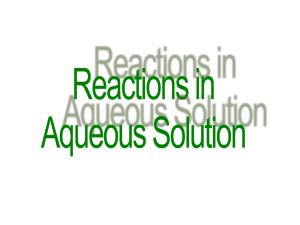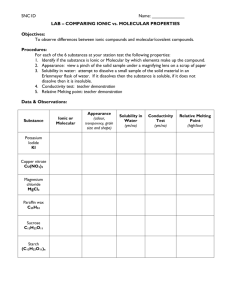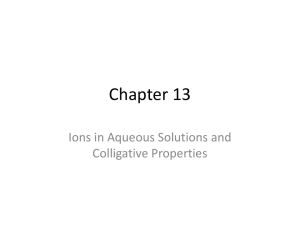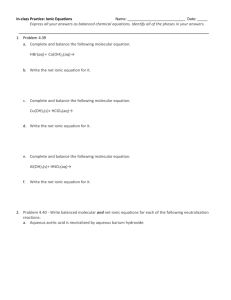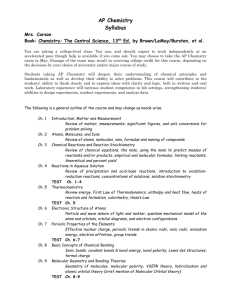What Happens When a Solute Dissolves?
advertisement
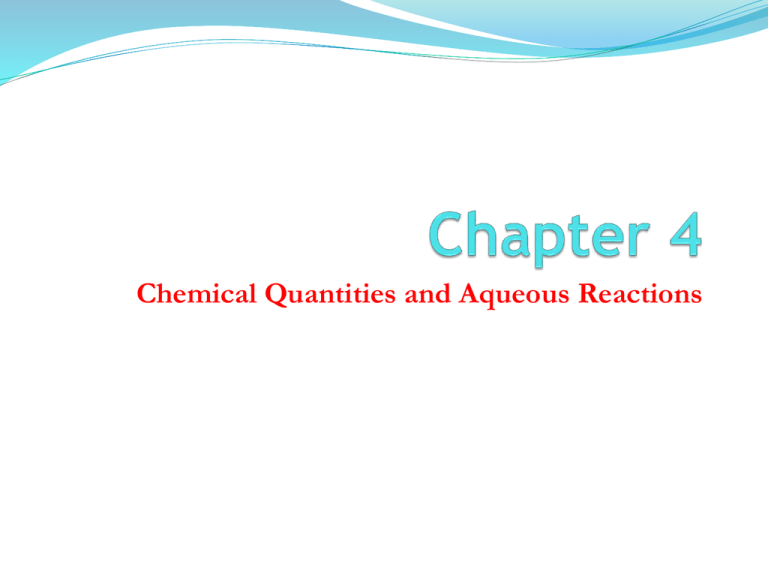
Chemical Quantities and Aqueous Reactions
What Happens When a Solute Dissolves?
there are attractive forces between the solute particles holding
them together
there are also attractive forces between the solvent molecules
when we mix the solute with the solvent, there are attractive
forces between the solute particles and the solvent molecules
if the attractions between solute and solvent are strong
enough, the solute will dissolve
2
Table Salt Dissolving in Water
Each ion is attracted to the
surrounding water molecules
and pulled off and away from
the crystal
When it enters the solution,
the ion is surrounded by water
molecules, insulating it from
other ions
The result is a solution with
free moving charged particles
able to conduct electricity
Tro, Chemistry: A Molecular Approach
3
Electrolytes and Nonelectrolytes
materials that dissolve in water
to form a solution that will
conduct electricity are called
electrolytes
materials that dissolve in water
to form a solution that will not
conduct electricity are called
nonelectrolytes
Tro, Chemistry: A Molecular Approach
4
Molecular View of
Electrolytes and Nonelectrolytes
in order to conduct electricity, a material must have
charged particles that are able to flow
electrolyte solutions all contain ions dissolved in the water
ionic compounds are electrolytes because they all dissociate into
their ions when they dissolve
nonelectrolyte solutions contain whole molecules
dissolved in the water
generally, molecular compounds do not ionize when they
dissolve in water
the notable exception being molecular acids
Tro, Chemistry: A Molecular Approach
5
Salt vs. Sugar Dissolved in Water
ionic compounds dissociate into ions
when they dissolve
molecular compounds do not dissociate
when they dissolve
Tro, Chemistry: A Molecular Approach
6
Acids
acids are molecular compounds that ionize when they
dissolve in water
the molecules are pulled apart by their attraction for the water
when acids ionize, they form H+ cations and anions
the percentage of molecules that ionize varies from one
acid to another
acids that ionize virtually 100% are called strong acids
HCl(aq) H+(aq) + Cl-(aq)
acids that only ionize a small percentage are called weak
acids
HF(aq) H+(aq) + F-(aq)
Tro, Chemistry: A Molecular Approach
7
Strong and Weak Electrolytes
strong electrolytes are materials that dissolve completely
as ions
ionic compounds and strong acids
their solutions conduct electricity well
weak electrolytes are materials that dissolve mostly as
molecules, but partially as ions
weak acids
their solutions conduct electricity, but not well
when compounds containing a polyatomic ion dissolve,
the polyatomic ion stays together
Na2SO4(aq) 2 Na+(aq) + SO42-(aq)
HC2H3O2(aq) H+(aq) + C2H3O2-(aq)
Tro, Chemistry: A Molecular Approach
8
Classes of Dissolved Materials
Tro, Chemistry: A Molecular Approach
9
Solubility of Ionic Compounds
compounds that dissolve in a solvent are said to be soluble,
while those that do not are said to be insoluble
NaCl is soluble in water, AgCl is insoluble in water
the degree of solubility depends on the temperature
even insoluble compounds dissolve, just not enough to be
meaningful
Tro, Chemistry: A Molecular Approach
10
When Will a Salt Dissolve?
Predicting whether a compound will dissolve in water is not
easy
The best way to do it is to do some experiments to test
whether a compound will dissolve in water, then develop
some rules based on those experimental results
we call this method the empirical method
Tro, Chemistry: A Molecular Approach
11
Solubility Rules
Rule
Important Exceptions
1. All nitrate (NO3¯), nitrite (NO2¯), chlorate (ClO3¯) and
perchlorate (ClO4¯) salts are soluble.
Silver nitrite and potassium perchlorate are considered slightly
soluble.
2. Essentially, all alkali metal (Li+, Na+, K+, Rb+, Cs+) and
ammonium (NH4+) salts are soluble.
Some Li+ are insoluble.
3. Most halogen (Cl¯, Br¯, I¯) salts are soluble.
Ag+, Pb2+, Hg22+, Cu+, Tl+ (Pb2+ halogens are soluble in hot
water.) HgBr2 is slightly soluble.
4. Most acetate (C2H3O2¯) salts are soluble.
Ag+, Hg22+
5. Most sulfate (SO42¯) salts are soluble.
Ca2+, Sr2+, Ba2+, Ra2+, Pb2+, Ag+, Hg2+ (Some sources consider
calcium sulfate and silver sulfate to be slightly soluble.)
(S2¯)
All alkali metal and alkaline earth (Be2+, Mg2+, Ca2+, Sr2+, Ba2+,
Ra2+) sulfides are soluble. Ammonium sulfide is soluble. (Some
sources consider MgS, CaS and BaS to be slightly soluble.)
6. Many sulfides
are insoluble.
7. Most borates (BO32¯), carbonates (CO32¯), chromates
(CrO42¯), phosphates (PO43¯), and sulfites (SO32¯) are slightly MgCrO4 is soluble, MgSO3 is slightly soluble.
soluble.
7. Most hydroxide (OH¯) salts are insoluble
Alkali metal hydroxides are soluble.
Ba2+, Sr2+, Ca2+, Tl+ are considered slightly soluble.
Precipitation Reactions
reactions between aqueous solutions of ionic compounds
that produce an ionic compound that is insoluble in water
are called precipitation reactions and the insoluble
product is called a precipitate
Tro, Chemistry: A Molecular Approach
13
2 KI(aq) + Pb(NO3)2(aq) PbI2(s) + 2 KNO3(aq)
14
No Precipitate Formation =
No Reaction
KI(aq) + NaCl(aq) KCl(aq) + NaI(aq)
all ions still present, no reaction
Tro, Chemistry: A Molecular Approach
15
Example 4.10 – Write the equation for the precipitation
reaction between an aqueous solution of potassium carbonate
and an aqueous solution of nickel(II) chloride
1.
Write the formulas of the reactants
K2CO3(aq) + NiCl2(aq)
2.
Determine the possible products
Determine the ions present
(K+ + CO32-) + (Ni2+ + Cl-)
b) Exchange the Ions
(K+ + CO32-) + (Ni2+ + Cl-) (K+ + Cl-) + (Ni2+ + CO32-)
c) Write the formulas of the products
a)
cross charges and reduce
K2CO3(aq) + NiCl2(aq) KCl + NiCO3
Example 4.10 – Write the equation for the precipitation
reaction between an aqueous solution of potassium carbonate
and an aqueous solution of nickel(II) chloride
3.
Determine the solubility of each product
KCl is soluble
NiCO3 is insoluble
4.
If both products soluble, write no reaction
does not apply since NiCO3 is insoluble
Tro, Chemistry: A Molecular Approach
17
Example 4.10 – Write the equation for the precipitation
reaction between an aqueous solution of potassium carbonate
and an aqueous solution of nickel(II) chloride
5.
6.
Write (aq) next to soluble products and (s) next to insoluble
products
K2CO3(aq) + NiCl2(aq) KCl(aq) + NiCO3(s)
Balance the Equation
K2CO3(aq) + NiCl2(aq) 2 KCl(aq) + NiCO3(s)
Tro, Chemistry: A Molecular Approach
18
Ionic Equations
equations which describe the chemicals put into the water and
the product molecules are called molecular equations
2 KOH(aq) + Mg(NO3)2(aq) 2 KNO3(aq) + Mg(OH)2(s)
equations which describe the actual dissolved species are called
complete ionic equations
aqueous strong electrolytes are written as ions
soluble salts, strong acids, strong bases
insoluble substances, weak electrolytes, and nonelectrolytes written in
molecule form
solids, liquids, and gases are not dissolved, therefore molecule form
2K+1(aq) + 2OH-1(aq) + Mg+2(aq) + 2NO3-1(aq) 2K+1(aq) + 2NO3-1(aq) + Mg(OH)2(s)
Tro, Chemistry: A Molecular Approach
19
Ionic Equations
ions that are both reactants and products are called
spectator ions
2K+1(aq) + 2OH-1(aq) + Mg+2(aq) + 2NO3-1(aq) 2K+1(aq) + 2NO3-1(aq) + Mg(OH)2(s)
• an ionic equation in which the spectator ions are
removed is called a net ionic equation
2OH-1(aq) + Mg+2(aq) Mg(OH)2(s)
Tro, Chemistry: A Molecular Approach
20
Example
Write a balanced molecular equation, ionic equation and net
ionic equation for the following reactions:
K2S(aq) + Fe(NO3)2(aq)
NaCl(aq) + NH4(aq)CO3
Acid-Base Reactions
also called neutralization reactions because the acid and base
neutralize each other’s properties
2 HNO3(aq) + Ca(OH)2(aq) Ca(NO3)2(aq) + 2 H2O(l)
the net ionic equation for an acid-base reaction is
H+(aq) + OH(aq) H2O(l)
as long as the salt that forms is soluble in water
Tro, Chemistry: A Molecular Approach
22
Acids
and
Bases
in
Solution
acids ionize in water to form H ions
+
more precisely, the H from the acid molecule is donated to a water
molecule to form hydronium ion, H3O+
most chemists use H+ and H3O+ interchangeably
bases dissociate in water to form OH ions
bases, like NH3, that do not contain OH ions, produce OH by
pulling H off water molecules
in the reaction of an acid with a base, the H+ from the acid
combines with the OH from the base to make water
the cation from the base combines with the anion from the
acid to make the salt
acid + base salt + water
Tro, Chemistry: A Molecular Approach
23
Common Acids
Chemical Name
Formula
Uses
Strength
Perchloric Acid
HClO4
explosives, catalyst
Strong
Nitric Acid
HNO3
explosives, fertilizer, dye, glue
Strong
Sulfuric Acid
H2SO4
Hydrochloric Acid
HCl
Phosphoric Acid
H3PO4
Chloric Acid
HClO3
Acetic Acid
HC2H3O2
Hydrofluoric Acid
Carbonic Acid
Hypochlorous Acid
HF
H2CO3
HClO
Boric Acid
H3BO3
explosives, fertilizer, dye, glue,
Strong
batteries
metal cleaning, food prep, ore
Strong
refining, stomach acid
fertilizer, plastics & rubber,
Moderate
food preservation
explosives
Moderate
plastics & rubber, food
Weak
preservation, vinegar
metal cleaning, glass etching
Weak
sanitizer
Weak
Weak
eye wash
Weak
soda water
Common Bases
Chemical
Name
sodium
hydroxide
potassium
hydroxide
calcium
hydroxide
sodium
bicarbonate
magnesium
hydroxide
ammonium
hydroxide
Formula
NaOH
Common
Name
lye,
caustic soda
Uses
soap, plastic,
petrol refining
soap, cotton,
electroplating
Strength
Strong
KOH
caustic potash
Ca(OH)2
slaked lime
cement
Strong
NaHCO3
baking soda
cooking, antacid
Weak
Mg(OH)2
milk of
magnesia
antacid
Weak
NH4OH,
{NH3(aq)}
ammonia
water
detergent,
fertilizer,
explosives, fibers
Weak
Tro, Chemistry: A Molecular Approach
Strong
25
HCl(aq) + NaOH(aq) NaCl(aq) + H2O(l)
Tro, Chemistry: A Molecular Approach
26
Example
Write the molecular, ionic, and net-ionic equation for
the reaction of
aqueous nitric acid with aqueous calcium hydroxide
Aqueous sulfuric acid and aqueous potassium hydroxide
Aqueous hydrofluoric acid and aqueous sodium hydroxide
Tro, Chemistry: A Molecular Approach
27


